A year ago today, out for an afternoon walk in Central Park, I came upon a few interestingly textured round hard green fruit along a path I often take. Someone explained to me that it was an Osage Orange from the Osage Tree. I immediately looked it up of course, and the next day I went back to pick up some more of the Osage Oranges (which of course are not oranges) because the wind was rising and soon they would fall, be eaten by squirrels, decompose, and also because someone had asked me where the tree was located in the Park and I wanted to locate it for them—in fact it is a small grove of Osage Trees right along the Western edge of the Park near 68th street and because the tree, its fruit, and its story intrigued me. I fell in love with it and what a gift to find something that gave that sense of discovery and yet had always been so close to home.
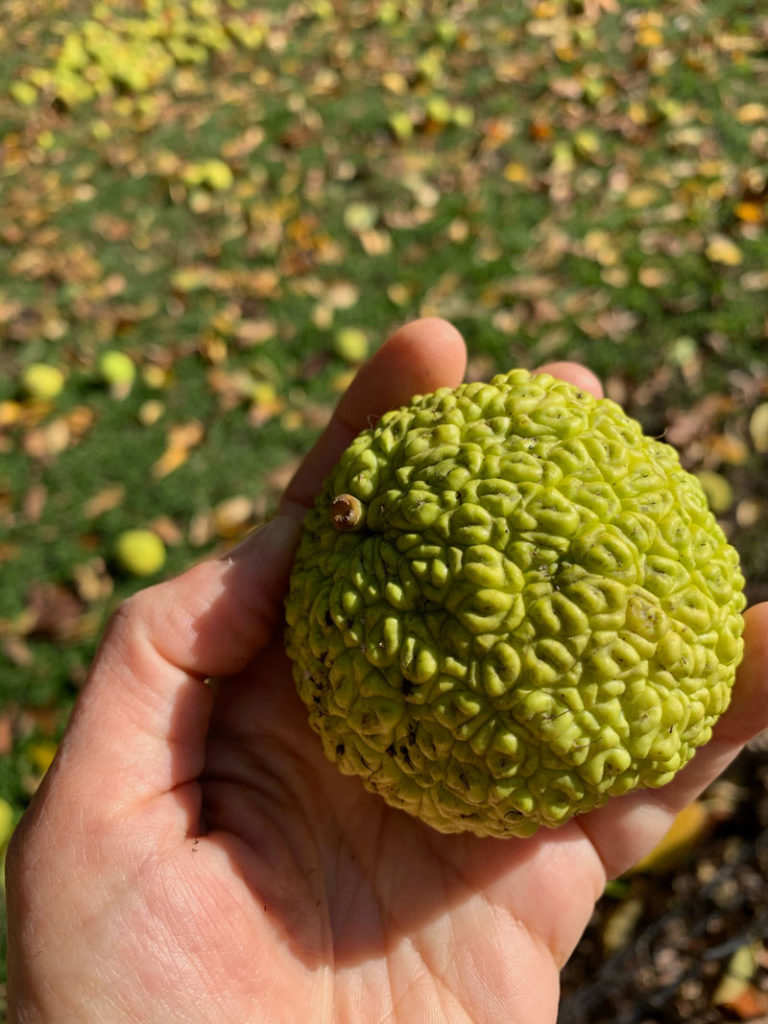
That second day, one year ago, a young woman noticed me gathering the green fruit and asked me about them just as I had asked passersby the day before. I could feel the tree and its fruit generate a chain of conversation as each person was drawn to the curiousness of these creature-like green balls lying on the ground. As I looked up and took some notes and pictures, she pointed to where there were still some on the branches. Then out of blue she asked me if I was an artist. I said yes in fact I am an artist but what made you ask that? She said that I had so much energy and seemed so purposeful that she wondered if I was an artist gathering the fruit for an art project. I thought, well I am gathering them for a project, Project Save My Life By Feeding My Spirit. I said that I found that being in the park with some (carefully landscaped) nature soothed my spirits. She mentioned that she was finding solace in the park since she had recently broken up with a guy who turned out to be a total liar (I thought, well as a nation we’re all trying to break up with a liar but he’s also a stalker and has crazy evil friends, but that is another story). Then she quoted something she had read by Alan Watts that had made an impression on her, “As the ocean ‘waves,’ the universe ‘peoples.'” The full quote as I found it online: “We do not ‘come into’ this world; we come out of it, as leaves from a tree. As the ocean ‘waves,’ the universe ‘peoples.’ Every individual is an expression of the whole realm of nature, a unique action of the total universe.”
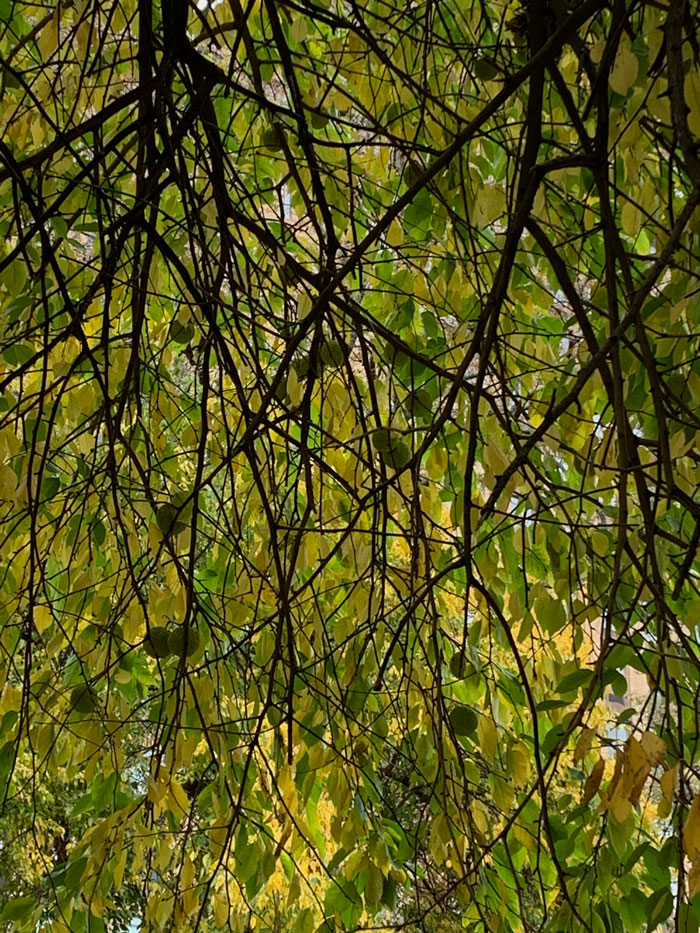
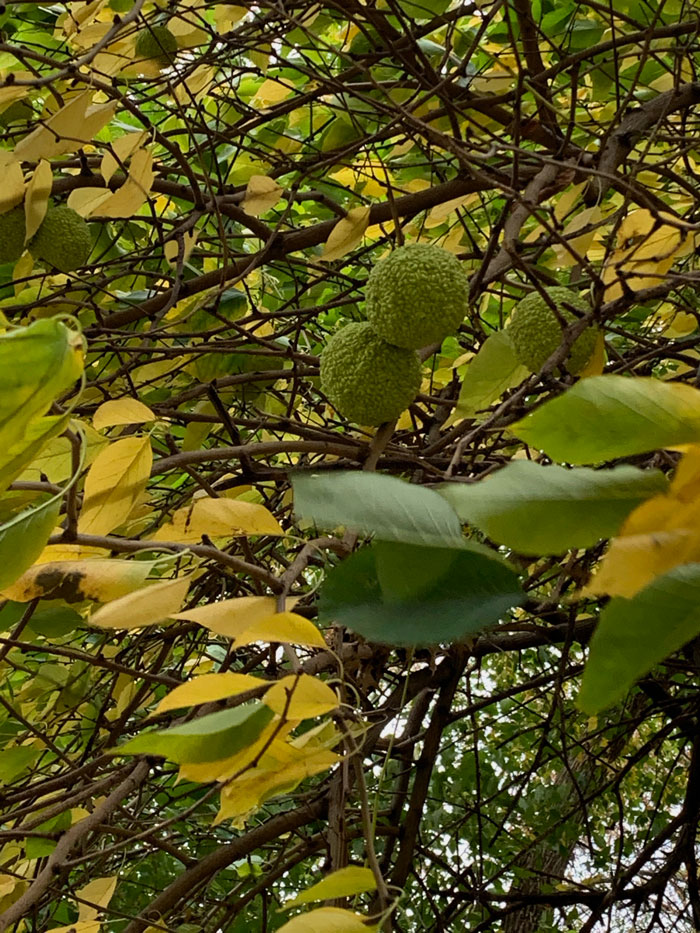
I thought about how the Osage tree at this point in the fall, in mid-November, has both green and yellow leaves, in fact still more green than yellow, and it still has some of its green fruit hanging on its branches. I’m at the beginning of the eighth decade of my life (I say that because it seems kind of incredible to me) but I am also as summer green as I am autumn yellow. I often despair but still have energy and spirit and hope to continue bearing fruit. The Osage tree is described (in the Wikipedia entry under its etymological name Maclura pomifera) as an “evolutionary anachronism” because of its roots in the Pleistocene era but it has many benefits: not only do squirrels and pigeons seem to love the fruit, but the trees’ deep roots and growth patterns make them ideal for hedges. Also the fruit are said to repel insects. The fruit at this point in the year have a slightly astringent and medicinal but not unpleasant smell which is perhaps what keeps insects away. As the ones I kept from last year attest, they shrivel and shrink with age.

Being an artist is difficult. Basically you are engaged in the making or writing or imagining something which in most cases no one else needs and few are interested in and, even if at some point you are in step with the Zeitgeist, the radical shifts in fashion and reversals of ideology that seem to occur pretty much every decade since the beginning of the modernist era make becoming an “evolutionary anachronism” nearly inescapable. An older artist has the task of remaining alive in their work—and also literally–in the face of an infatuation on the part of the art market with youth or, especially in the case of women, with such great old age that the women artists no longer pose a threat to the system and when they can no longer do more work with the belated support. In previous writings (see note below*) and artworks, I have noted the three ages of a woman artist’s life, “Young and Naked,” “Still Too Young,” and “Not Dead Enough.” I found support in the green leaves of the Osage Tree, in its unusual fruit, its evolutionary survival despite humans deeming it an evolutionary anachronism, and the fact that I can look for the tree again in the spring. Which I did.

And now I have come to another mid-November, the Osage Tree Grove still is more green than yellow, there seem to be fewer Osage Oranges on the ground, and yesterday the grove was fenced off except for a few people in some kind of Déjeuner sur l’herbe scene which I took as a living advertisement for an events business.
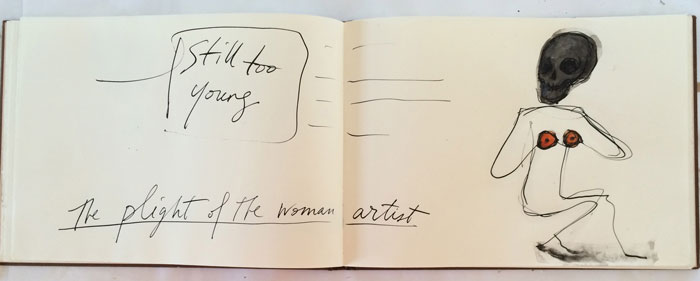
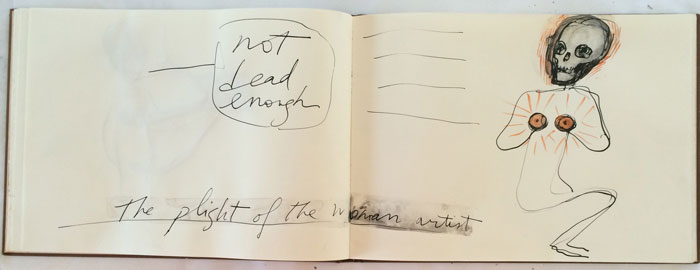
Now back to the studio and the prompts and permissions I’ve evolved over the years — “just paint a Mira Schor” I said to myself when I was in my twenties and that barely made sense because at that early stage, what, after all, was that? And then about twelve years ago I told myself, “just paint the worst or the stupidest painting (because you have already painted the stupidest painting).”
It gets harder to successfully play such tricks on yourself and the many shifts in art hierarchies, values, and fashion can begin to wear one down, particularly when they all too disconcertingly resemble something you have witnessed before. It is impressive and overwhelming to see so many young artists doing amazingly consistent, accomplished, impressive work in a style arrived at relatively early in their practice—and yet, for anyone who has been around for a while, in styles that seem unnervingly like older art styles including ones once successful, radical, or reviled. It is a weird thing–one wants modes of thinking in art to survive, one hopes valued traditions and forms continue to exist, but one hopes for acknowledgement and for a sense of interaction with the antecedents. Some of the past I experienced was pretty contingent so it is disconcerting when elements recur as efficient, consistent product. On the other hand, we see very successful older artists that are turning out work in their trademark style to satisfy their collectors long past the time when they were animated by search and discovery—in a way that makes me think of actresses who keep having cosmetic surgery to keep viable but thereby deprive us of what they might actually look like at 70 or 80 or 90. We know how interesting Henry Fonda’s face was in later life but we will never see that reality of Jane Fonda.
In a conversation about this, on the pattern of Artist X turning out Artist X works, I spontaneously said, “there is no Mira Schor,” echoing yet curiously altering my mantra from my 20s, “just paint a Mira Schor.” Yet, with my new spirit tree inspiring me and with my fresh Osage oranges scattered in the rooms I occupy, I’ll continue the project the young woman in the park apparently sensed, with all my mantras including a more recent one, “my work has to be a reflection of who I am, right this minute,” and the newest one–I return to my French education for this–“Il faut tenir le coup”–you have to take the blows, hang in there, hang tough–with this morning’s realization that whatever the market’s most recent stylistic infatuation is, it will shortly fade for whatever the next one will be, and that too will be as much a revenant or a replicant as it will be new. That doesn’t make me happy, the spinning bottle may not stop at a location near me, but it may help me adjust my perspective and hope the deep roots of the Osage Tree continue to yield bright green (though inedible) tough fruit.

- “Miss Piggy and Madame de Beauvoir: A New Fable of La Fontaine: Cochon et Castor,” June 1, 2015 ; “Just a short message from Venus,” June 24, 2015; “Normalizing Inequity,” May 9, 2016
*Susan Bee and I invited a number of artists who had been working for at least twenty years (the amount of time we ourselves had been artists at that date) to answer a few questions about their practice “Over Time” for “Over Time: A Forum on Art Making,” published in our journal M/E/A/N/I/N/G, Issue #10, November 1991. Among the twenty-four artists who responded were Leon Golub, Nancy Grossman, Howardena Pindell, Carolee Schneemann, Lawrence Weiner, and Faith Wilding. A facsimile copy of this issue of M/E/A/N/I/N/G can be found here.
